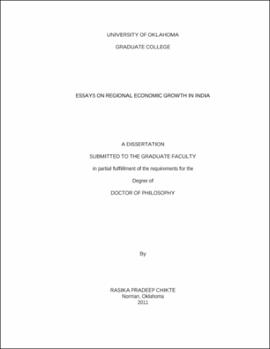| dc.contributor.advisor | Grier, Robin | |
| dc.creator | Chikte, Rasika Pradeep | |
| dc.date.accessioned | 2019-04-27T21:41:29Z | |
| dc.date.available | 2019-04-27T21:41:29Z | |
| dc.date.issued | 2011 | |
| dc.identifier | 9996448202042 | |
| dc.identifier.uri | https://hdl.handle.net/11244/319351 | |
| dc.description.abstract | In the first chapter I study regional growth and sub-national income convergence in India in the context of economic reforms that were undertaken since 1991. I also examine convergence in development inputs such as population growth, literacy and investment at the sub-national level. My results show that there is a strong evidence of divergence in per capita income of the 15 states studied in the sample. The standard deviation of net state domestic product has increased over time indicating no evidence of convergence in the pre- or post-reforms period. Population, state capital expenditure and commercial bank credit have also diverged over time across these 15 Indian states. However, literacy shows evidence of convergence across states. | |
| dc.description.abstract | In the second chapter I study sectoral output patterns and growth across states in India during pre- and post economic reforms period (1970-1990 and 1991-2005). I also study the relationship between per capita income and the shares of primary, secondary, and tertiary sectors in the total output. The data shows that the growth of secondary sector has stagnated in India. Thus there was an increase of just 1.45 percent in the secondary sector mean share in total output during post-reform period. The primary sector's share in the total output has declined with increasing per capita income conforming the theoretical prediction. As far as the tertiary sector is concerned, it has experienced rapid growth over the sample period. However, employment growth in the tertiary sector has been very slow. I have also investigated for the effect of increasing per capita income and other development inputs like investment, population and literacy rate on the changes in sectoral shares. I find literacy rates and state capital expenditure to be positively and significantly linked to the increase in tertiary sector output. | |
| dc.description.abstract | In the third chapter I study the relationship between socio-political violence and economic growth across 16 states in India. I find that in India at large riots do not have a significant effect on NSDP growth. In spite of the various socio-political disturbances in terms of caste, language and ethnic issues, India has continued to develop economically. The episodes of socio-political problems and related violence do not seem to have put a drag on India's fast pace of economic growth. However, I find that in case of seven states that are affected with Maoist/Naxalite violence, riots have a significant growth-inhibiting effect. | |
| dc.format.extent | 135 pages | |
| dc.format.medium | application.pdf | |
| dc.language | en_US | |
| dc.relation.requires | Adobe Acrobat Reader | |
| dc.subject | India--Economic conditions--1991- | |
| dc.subject | Economic development--India | |
| dc.subject | Convergence (Economics)--India | |
| dc.subject | Violence--India | |
| dc.title | Essays on regional economic growth in India | |
| dc.type | text | |
| dc.type | document | |
| dc.thesis.degree | Ph.D. | |
| ou.group | College of Arts and Sciences::Department of Economics | |
